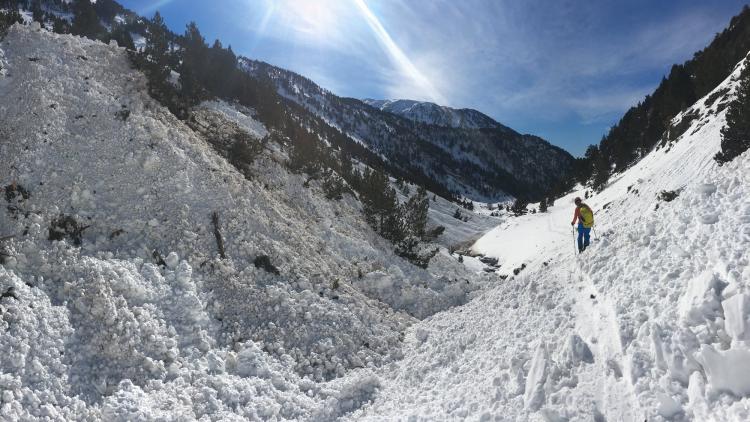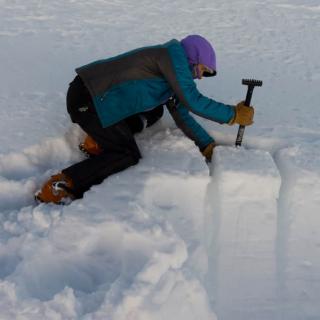Avalanches are the most significant hazard a ski mountaineer is likely to encounter. Having good avalanche awareness, particularly to avoid avalanches in the first place, is a key part of safer ski touring. This page provides information about key resources to help you do this:
- planning a ski tour and assessing risk
- avalanche bulletins
- snowpack stability
- human factors
- essential equipment
- resources, including case studies, videos, training courses and books.
Information and advice about companion search & rescue can be found here: Companion Search & Rescue
Planning a ski tour and assessing risk
There are many online articles which provide an excellent introduction and overview of avalanche awareness, including planning a ski tour and assessing risk. Examples include:
- The Swiss Institute for Snow and Avalanche Research (SLF) has much useful information, including an excellent summary brochure, which can also be ordered (free) as a printed version - you may want to get a copy for everyone on your tour.
- There are an increasing number of websites and apps to help plan your ski tours, including: White Risk website and app; Fatmap; skitourenguru; and Be Avalanche Aware.
- The Alpine Ski Club website has some good webpages covering key parts of the process: Avalanche / Defensive Mountaineering / Planning Checklists / Avalanche Risk Factor / Search and Rescue
- Ortovox - Safety Academy Avalanche Basics
- Avalanche Canada – Online Avalanche Course
- “The White Reaper is Stalking You” – article by Andy Perkins in the Eagle Ski Club Yearbook 2012
- “Avalanche Notes for Skiers” by Rob Collister in the Eagle Ski Club Yearbook 2001
There is an excellent article by Karl Klassen on Avalanche Risk Management is in the 2014 Eagle Ski Club Yearbook.
The Munter 3 x 3 system is a well known approach which provides a structure for assessing risk in 3 areas:
- Snowpack & Weather
- Terrain
- Human Factors
at 3 stages in a tour:
- Regional – planning before the tour starts
- Local – on the day of the tour
- Zonal – at the exact location of a questionable slope
A useful summary of the 3x3 method is provided on the Alpine Ski Club site.
Avalanche Bulletins
The European Avalanche Warning Services enables easy access to avalanche information through a clickable map for Europe: www.avalanches.org
For Canada: www.avalanche.ca
Snowpack Stability
This video from Bruce Jamieson describes the different types of tests which can be performed to help assess the stability of the snowpack (Compression Test, Rutschblock Test, Shovel Shear Test etc).
This presentation describes the circumstances in which the various snowpack tests are best used. This presentation describes how noting the type of fracture in a compression test can provide useful information.
This paper by Alain Duclos & François Louchet describes mechanisms for triggering slabs.
Human Factors / Heuristic Traps
Many avalanche incidents happen to people who understand the risks and if they had been thinking logically would have avoided the situation, but who have used simple rules of thumb (“heuristics”) which have short circuited the decision-making process and led to accidents. This paper by Ian McCammon examines 4 “heuristic traps” – familiarity, social proof, commitment and scarcity. This presentation provides a thought provoking insight into human factors.
Equipment – Transceivers
The most important thing with any avalanche transceiver is to make sure you get lots of practice using your own device. However, transceiver technology has advanced a great deal over the last 10 years or so, and if you have an older model, it is well worth updating to a modern three-antennae version. These newer models make fine searching and multiple-burial searching easier - a minute or two saved in locating a victim could well be the difference between life and death.
The technology of avalanche transceivers is described in this article by Ken Marsden in the Eagle Ski Club Yearbook 2014. Avalanche transceivers can be disrupted by electromagnetic interference from other electronic devices, such as mobile phones, smart watches, cameras, etc and other devices with metal/foil content (such as a headlamp). The UIAA have produced guidance on this issue. The key elements are:
- in transmit mode, keep other electronic devices and metal/foil at least 20cm away from your avalanche transceiver, and your mobile phone on the opposite side from the transceiver
- in search mode, turn your mobile phone off (not flight mode) and keep all other devices, etc at least 50cm away from the transceiver
- if someone is required to use their phone (such as to call for help), they should be at least 10m away
- if you are wearing a smart watch, hold your transceiver in your opposite hand
You can find the full guidance here: UIAA guidance on electromagnetic interference in avalanche transceivers
Beacon Reviews provides a useful comparison of the different transceivers which are currently available.
Equipment – Shovels and Probes
In addition to an avalanche transceiver, it is important that every member of the party carries a shovel and a probe. Plastic shovels should not be used for ski touring – they are simply not strong enough to dig through avalanche debris.
Resources - case studies
There is an up-to-date library of avalanches, mostly in France, at:
https://www.data-avalanche.org/?lang=en
There is an archive of French avalanche reports here which is sometimes useful to look at
https://donneespubliques.meteofrance.fr/?fond=produit&id_produit=265&id_rubrique=50
The Swiss publish a very useful blog (may translate to English on your PC or phone) which summarises current snow and avalanche issues, as well as looking at individual avalanches:
https://www.slf.ch/fr/bulletin-davalanches-et-situation-nivologique/avablog
The Austrian service, Lawinendienst, do a very similar blog (you can change the language to English) at:
There are a number of individual case studies that provide a very valuable look into how avalanches can happen and the role of snow conditions, weather, terrain and human factors in these. Examples include:
- an avalanche and rescue, with key learning points, at Cherry Bowl in Canada
- an Avalanche Accident in Engelberg (video)
- an avalanche incident in Canada, which is a great example of how excitement and passion for skiing can take over rational decision making - "Wisdom from Wounds"
- an incident at Tunnel Creek in the USA.
Resources - videos
Here are some links to other useful videos:
- 'Know before you Go' is a collaborative initiative from North America with an excellent video.
- “A Dozen More Turns” A documentary about backcountry skiing, avalanches and how "human factors" can have dire consequences.
Resources - training courses
All resources listed on this page are useful, but there is no substitute for undertaking a training course in a mountain environment with a trained professional. The Club Touring Programme normally has one or more courses each year.
There are many other courses available, including those provided by:
Human factors can be critical in avalanche terrain and Mountain Assurance do an online course as well as training on a day. You can look at this here:
https://mountainassurance.co.uk/human-factors-fundamentals/
The Scottish Avalanche Information Service has produced an online training course as part of its Be Avalanche Aware programme. You can visit this course here:
https://be-avalanche-aware.teachable.com/p/be-avalanche-aware
Resources - books
There are a large number of books available on avalanche awareness.
Probably the best overall book in English is Bruce Tremper’s “Staying Alive in Avalanche Terrain” (second edition 2008). Bruce Tremper has also published a concise 'Avalanche Essentials' book in 2013 which is more easily portable, but still covers most of what you need to know.
Although it is a general instruction book, "Ski Touring" by Bruce Goodlad has a very useful chapter on Avalanche Awareness.
There can be significant differences between the snowpack and weather conditions in North America / European Alps / Scotland, so this may need to be born in mind, when reading a book from an author in one of those regions.
For Scotland, see “A Chance in a Million?” by Bob Barton and Blyth Wright (second edition 2000).
2019 Yearbook Quiz Answers
These are the answers to the avalanche skills quiz on page 170 of the 2019 year book. All the answers are in the leaflet “Caution avalanches” distributed with the year book and downloadable from here:https://www.wsl.ch/en/publications/caution-avalanches.html
Trip planning
1.What 3 items of avalanche safety kit should you always carry?
Avalanche transceiver (beacon), shovel and probe. Have you got these out since last season? A peer to peer transceiver session with other ESC members in a local park is a good way to spend a few hours in Autumn.
2.What are the words and numbers that avalanche bulletin use to describe the avalanche danger?
1 low, 2, moderate, 3 considerable, 4 high, 5 very high. Get in the habit of referring to the avalanche danger using the words not numbers. “Considerable” sounds much more risky than 3/5.
3.An example danger plot is shown in the year book. If you were trying to get avalanched where you go today?
in the plot shown this would be above 1800M and in the quadrants NE through S to SE. A good mental exercise when looking at avalanche forecasts is to think “where would I go today if I wanted to get avalanched?”
4.There are 5 different types of typical snow (avalanche) problem? Can you list these?
New snow, wind drifted snow, old snow, wet snow, glide snow.
Local evaluation
1.List 3 observations about your surroundings/conditions that you would particularly note.
These could include: recent slab avalanche activity, whumpfing sounds, shooting cracks, fresh deposits of wind drifted snow.
2.Human factors are now known to be an extremely important factor in avalanche accidents. Can you list 3 patterns of thinking (“heuristic traps”) that increase the risk of the group being avalanched.
These are listed in the panel of the leaflet (top left reverse side) headed “Human factors”. Many Eagles find the acronym “FACETS” a useful one (explained in the Back Country video ).
The individual slope
1.How is steep defined in degrees?
More than 30 degrees
2.If you need to put in kick turns to ascend a slope what does this suggest about slope angle?
It suggests the slope is approximately 30 degrees or more.
3.How can the angle of the slope be determined from a map?Use an “angle card’ such as the one sent to all members in the past . This allows angle measurement from contours. A number of countries now have colouring on maps for different slope angles. This may only be available electronically


